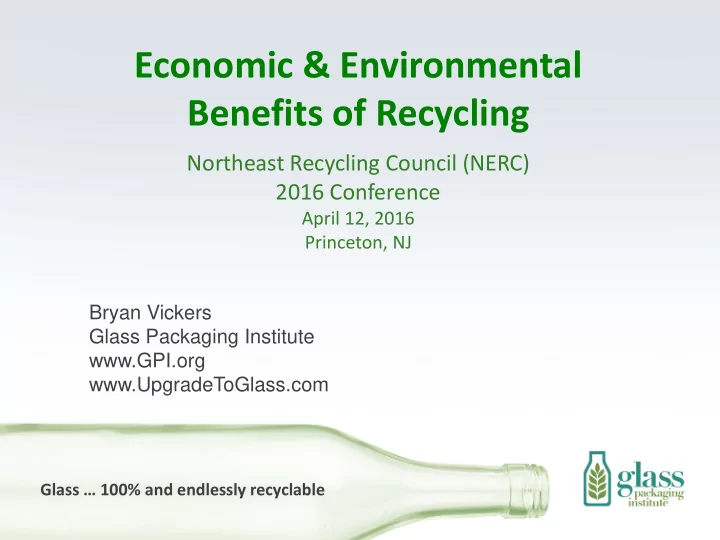

Economic & Environmental Benefits of Recycling Northeast Recycling Council (NERC) 2016 Conference April 12, 2016 Princeton, NJ Bryan Vickers Glass Packaging Institute www.GPI.org www.UpgradeToGlass.com Glass … 100% and endlessly recyclable
Overview • A brief look at the North American glass container industry • The big picture look into glass recycling: – Why it counts – Challenges – Glass Industry Initiatives to improve supply chain value, market accessibility and transparency, strategic partnerships and best practices 2
Glass Containers: Industry Overview
Glass Containers: Industry Overview • U.S. glass container manufacturers operate 45 plants in 22 states • Annual $5.5 billion industry • Approximately 28 billion glass containers manufactured in 2015 • Employs 18,000 Americans in high-paying, benefit-provided careers • Glass bottles reduced in weight by more than 40% between 1970 and 2000 4
2015 U.S. Glass Container Shipments by Category Beer (57%) Food (18%) Beverages (9%) Wine (9%) Liquor (4%) Ready to Drink (3%) Other (0.2%) Source: Glass Packaging Institute (GPI)
Glass Container Recycling
Why Recycle Glass Containers? • Energy and GHG emissions reduced by 1/3 per ton for every ton of recycled glass used • 100% and endlessly recyclable--can be substituted for up to 95% of raw materials • Reduces emissions, raw materials use, extends the life of plant equipment • 2.4 million tons/annually recycled glass used for new bottles and jars 7
Glass Container Recycling: Consumer Attitudes *Source: 2016 national poll by SurveyUSA
Helps Communities Meet Recycling Goals
Glass Container Recycling Facts • 59 glass processors in 29 states operated by 22 companies • Recycling rates*: – 41% of beer and soft drink bottles – 34% of wine and liquor bottles – 34.1% of all glass containers Average recycled content of glass – 10 states with refund containers risen from 26% in 2008 to 33% programs average 63% glass at the end of 2014 container recycling; other states average roughly 24% * Sources: U.S. EPA, Municipal Solid Waste Generation, Recycling, and Disposal in the United States: Facts and Figures for 2012, and Container Recycling Institute
End-Markets for Recovered Glass Uses for Glass from Single Stream Programs 21 Recycled (Containers & Insulation) 60 19 Downcycled (Abrasives & Aggregates) Trash (Landfilled) Source: Container Recycling Institute
Glass Container Recycling: Challenges
Single Stream Recycling: Packaging Stream NEW TON OLD TON Lighter, less mass * THE Glass is PACKAGING now a quarter of STREAM IS More units per ton Single EVOLVING Stream volume in non- More Types of Material deposit states Greater percentage of material with less commodity value (glass, increase some plastics like film and PS)
Single Stream Recycling: MRF Processing Challenges • Increased contamination of inbound supply • As fiber decreases, glass is growing percent of recycling stream • SS MRFs initially designed to “remove” glass, not sort it • Glass clean up systems are expensive to maintain Sources: 2007 Comparative Study on Public vs. Private MRFs, 2012 GAA study on Wisconsin-Area MRFs, ISRI Moore Presentation April 2015
Single Stream Recycling: Commodities Values • Commodities from curbside recycling processing economics $125 have deteriorated for six consecutive years • Over $37/ton of commodity value lost $67 per avg. single stream ton • Over $1B value loss to the industry per year
Single Stream Recycling: Glass Processor Challenges • Glass is “negatively sorted” so disproportionally impacted by contamination • Majority of MRFs have a glass breaker with 2” screens • “Glass” stream can contain up to 50% unwanted material: Post MRF, prior to glass processor – Organics – shredded paper, food, etc. – Plastics – syringes, needles, caps, etc. – Ceramics – cups, plates, etc. – Moisture – winter, comes in with organics/shredded paper 16
Landfilling: Environmental Costs & Economic Benefits Climate Change • Landfilling valuable commodities contributes to GHG emissions • Landfills are third largest source of U.S. methane emissions (18%)* • Nine states have landfill moratoriums Landfill Owner Benefits Financially • Landfill business has higher short- term profitability, but results in long-term degradation to recycling *Source: US EPA
Glass Container Recycling: GPI Initiatives
Improve Supply Chain Value & Accessibility www.GPI.org: Connecting the dots to the glass recycling chain
Partnership With Fiberglass Industry • Operates 36 plants in North America • Recycled glass is a critical manufacturing input • Similar to the glass container industry, requires properly sorted glass that meets industry specifications • Purchased roughly 750,000 tons of recycled glass in 2015
MRF Initiatives in North Carolina • GPI grants to two MRFs for improving glass processing and handling (Asheville and Raleigh) • MRFs to report on changes in glass recovery efforts in one year • 3 glass container plants in-state
Targeted Outreach & Glass MRF Spec • Outreach to state and local recycling officials & organizations • Establishing a “Glass MRF Spec” under consideration with ISRI (Institute of Scrap Recycling Industries)
Glass Recycling Coalition • Glass Industry Value Chain: ‒ Diageo ‒ New Belgium Brewing ‒ Glass Packaging Institute ‒ Heineken ‒ Strategic Materials, Inc. ‒ Sierra Nevada ‒ Ripple Glass ‒ Owens Corning Fiberglass ‒ Ardagh ‒ O-I ‒ NAIMA (Insulation Manufacturers Association) ‒ Gallo ‒ Goose Island ‒ Rocky Mountain Bottle Co. • Recycling Industry: ‒ The Recycling Partnership ‒ Waste Management ‒ Republic ‒ NW&RA
Glass Recycling - Key Takeaways • Recycled glass provides significant energy, environmental, and GHG benefits • Consumers want to recycle glass – not see it landfilled • Glass in the curbside bin assists municipalities and states achieve recycling and recovery goals • GPI is working with a variety of packaging stakeholders to improve and strengthen the glass supply chain and recovery efforts
THANK YOU! Learn more about GPI and glass container recycling at www.GPI.org www.UpgradeToGlass.com or contact bvickers@pacellp.com Glass … 100% and endlessly recyclable
Recommend
More recommend